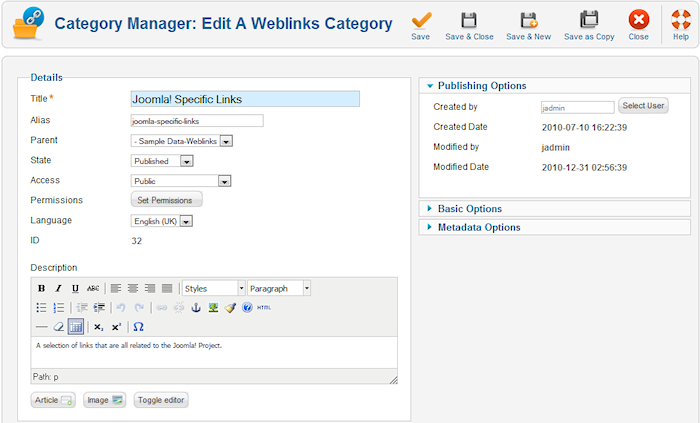Components Weblinks Categories Edit
From Joomla! Documentation
How to Access[edit]
Navigate to the Web Link Category Manager. To add a new Web Link Category, and click the "New" icon in the toolbar. To edit an existing Web Link Category, click the Category's Name, or check the Category's checkbox and press the "Edit" icon in the toolbar.
Description[edit]
This is where you can add a new Web Link Category or edit an existing one. Note that you need to create at least one Web Link Category before you can create a Web Link. Also, Web Link Categories are separate from other types of Categories, such as those for Articles, Banners, and News Feeds.
Screenshot[edit]
Details[edit]
- Title. The name of the item. For a Menu Item, the Title will display in the Menu. For an Article, Section, or Category, the Title may optionally be displayed on the web page. This entry is required. You can open the item for editing by clicking on the Title.
- Alias. The internal name of the item, also used in the URL when SEF is activated. Normally, you can leave this blank and Joomla! will fill in a default value. The default value is the Title or Name in lower case and with dashes instead of spaces. You may enter the Alias manually. The Alias should consist of lowercase letters and hyphens (-). No blank spaces or underscores are allowed. Note: If the title consists of non-Latin characters, the Alias will default to the current date and time, for example "2009-02-11-17-54-38".
- Parent. The item (category, menu item, and so on) that is the parent of the item being edited.
- State: State of the item. Possible values are:
- Published: The item is published. This is the only state that will allow regular website users to view this item.
- Unpublished: The item is unpublished.
- Archived: The item has been archived.
- Trashed: The item has been sent to the Trash.
- Access. Who can view this item. You can change an item's Access in its edit screen. See User Access Levels for more information.
- Language. Item language.
- ID. This is a unique identification number for this item assigned automatically by Joomla!. It is used to identify the item internally, and you cannot change this number. When creating a new item, this field displays 0 until you save the new entry, at which point a new ID is assigned to it.
Basic Options[edit]
- Alternative Layout. Specify a different layout than the one supplied by the component view or template overrides.
- Image. Choose an image to be displayed with this item/category in the front-end.
- Note. Item note.
Category Permissions[edit]
This section is where you can view and edit permissions for items that are part of this category.
The "Summary" tab shows an overview of effective permissions for each action/user group in a read-only table:
In this example, users that are part of the "Manager" group can create, delete, edit and edit the state of items in the category being edited, while those in the "Author" group can only create new items.
The other tabs, one for each action, let you edit permissions for each group:
(...)
Actions for which you can set permissions are:
- Create. Grants users the right to create new objects (for example: users, menu items, articles, weblinks, and so on).
- Delete. Grants users the right to delete existing objects.
- Edit. Grants users the right to edit existing objects.
- Edit State. Grants users the right to change existing objects state (Publish, Unpublish, Archive, Check In and Trash).
Metadata Options[edit]
- Meta Description. Optional text entered here will be added to the page's HTML output and may be displayed in search engine results.
- Meta Keywords. Optional comma-separated list that will be added to the HTML keywords output.
- Author. The author of this content.
- Robots. This will be added to the page's HTML output. Options are: Use Global, Index-Follow, No index-Follow, Index-No follow, No index-No follow, and Don't display robots tag.
- Created. Date and time when this item was created.
Toolbar[edit]
At the top right you will see the toolbar:
- Save. Saves the item and stays in the edit screen.
- Save & Close. Saves the item and closes the edit screen.
- Save & New. Saves the item and keeps the editing screen open and ready to create another item.
- Save as Copy. Saves this item under a new name, keeping the original item unmodified. This button is available only when editing an existing item, not when creating a new one.
- Close. Returns to the previous screen without saving your work. If you press Close while adding a new item, this new item will not be created. If you were modifying an existing item, the modifications will not be saved.
- Help. Opens this Help Screen.
Related Information[edit]
- To work with Web Links: Web Link Manager
- To work with Web Links Categories: Web Link Category Manager


